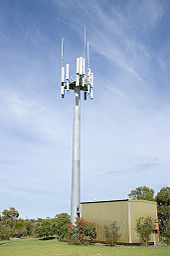Mobile phones send and receive radio signals with any number of cell site base stations fitted with microwave antennas. These sites are usually mounted on a tower, pole or building, located throughout populated areas, then connected to a cabled communication network and switching system. The phones have a low-power transceiver that transmits voice and data to the nearest cell sites, normally not more than 8 to 13 km (approximately 5 to 8 miles) away.
When the mobile phone or data device is turned on, it registers with the mobile telephone exchange, or switch, with its unique identifiers, and can then be alerted by the mobile switch when there is an incoming telephone call. The handset constantly listens for the strongest signal being received from the surrounding base stations, and is able to switch seamlessly between sites. As the user moves around the network, the "handoffs" are performed to allow the device to switch sites without interrupting the call.
Cell sites have relatively low-power (often only one or two watts) radio transmitters which broadcast their presence and relay communications between the mobile handsets and the switch. The switch in turn connects the call to another subscriber of the same wireless service provider or to the public telephone network, which includes the networks of other wireless carriers. Many of these sites are camouflaged to blend with existing environments, particularly in scenic areas.


Tidak ada komentar:
Posting Komentar